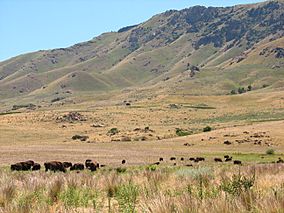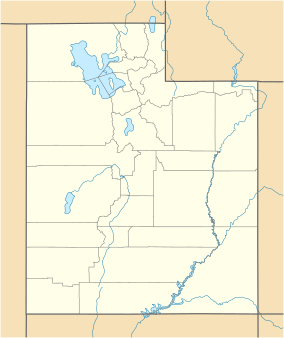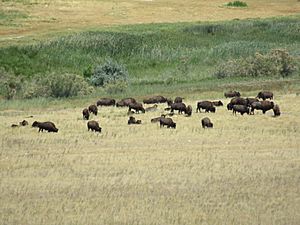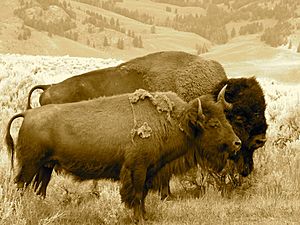Antelope Island bison herd facts for kids
Quick facts for kids Antelope Island bison herd |
|
|---|---|

Bison grazing on Antelope Island
|
|
| Location | Davis, Utah, United States |
| Elevation | 4,350 ft (1,330 m) |
| Established | 1893State Management since 1981 |
| Visitors | 280351 (in 2010) |
| Governing body | Utah State Parks |
| Website | Antelope Island State Park |
The Antelope Island bison herd lives in Antelope Island State Park in the Great Salt Lake, Utah. This herd of American bison (also called buffalo) has been on Antelope Island since 1893. The island got its name from the pronghorn antelope that explorers John C. Frémont and Kit Carson found there. Later, bison were brought to the island.
This herd is very important because it is one of the largest and oldest publicly owned bison herds in the United States. It is one of two bison herds managed by the State of Utah. The other is the Henry Mountains bison herd. The Antelope Island herd usually has between 550 and 700 bison.
Even though these bison are the common Prairie bison, they have a special genetic history. This makes them valuable for breeding and starting other bison herds. Many people enjoy watching the bison on Antelope Island because they are usually easy to find. In 2020, the podcast This is Love even featured the island and its bison.
Contents
Where the Bison Live
Bison can be found almost anywhere on Antelope Island. This includes the northern part near the causeway, which is a road connecting the island to the mainland. However, most bison often gather on the east side, close to the Fielding Garr Ranch.
Historically, American bison lived in river valleys, prairies, and plains. Their usual homes were open grasslands or areas with some trees and bushes. They also grazed in hilly or mountainous places that were not too steep. For example, bison in Yellowstone National Park are often found at high elevations.
Antelope Island is about 4,300 feet (1,310 meters) above sea level, with some peaks reaching 6,500 feet (1,980 meters). This is similar to the high plains in Colorado and Wyoming. Even though bison can roam all over the island, they tend to stay in the lower, flatter, grassy areas of the park.
History of the Herd
Millions of American bison once roamed North America. Some estimates say there were between 25 million and 60 million of them. They were possibly the most common large land animal on Earth. However, by the late 1880s, they were hunted so much that they almost disappeared.
It's possible bison once lived on Antelope Island, but they didn't have a lasting population. When early European explorers arrived, there were no bison on the island. As bison became rare across North America, a small group was brought to Antelope Island.
On February 15, 1893, twelve bison were brought to the island by boat. There were 4 male bison (bulls), 4 female bison (cows), and 4 calves. These 12 animals came from a small private herd in Texas. They became the starting group for the Antelope Island bison herd. By the early 1900s, there were several hundred bison on the island. The herd was managed from the Fielding Garr Ranch, and even today, bison often gather in that area.
One of the first silent movies, The Covered Wagon, was partly filmed on Antelope Island. The movie needed scenes with a buffalo hunt and a stampede. At that time, the Antelope Island herd was likely the largest bison herd in the United States. About 350 bison were herded into a stampede for the film. This movie helped create some common ideas seen in Western films, like "circling the wagons" when in danger.
It seems that the main reason Mr. Dooly started the herd on Antelope Island was for profit. By the 1890s, American bison were almost gone from most of their natural areas. John Dooly thought he could raise bison and charge people to hunt them. However, hunting bison for money didn't work out well. So, attempts to ranch them on Antelope Island stopped.
Bison hunting began on the island in 1896 and happened often until 1926. In 1926, a very large hunt, called the "Big Buffalo Hunt," took place. Most of the bison were killed in this single event. After this, public opinion changed in the 1920s. People started asking for the herd on the island to be protected. Today, a small amount of bison hunting still happens on the island.
In 1926, a final big hunt was organized. About 300-400 bison were reduced to only about 50. This was done by many hunters on horseback using modern rifles. This hunt was even covered by Time magazine.
John Dooly had sold the herd to A. H. Leonard in 1924. Leonard wanted to sell the bison to zoos, but he couldn't gather them. He then tried to offer the island and the bison to the United States Department of the Interior. Leonard hoped a national park would be created on the island to protect the herd. However, this didn't happen. Leonard then decided to raise more cattle on the island. To do this, the number of bison needed to be reduced.
Leonard announced a hunt for the fall of 1926. The hunt happened in November, even with protests from across the country. Newspapers like the New York World tried to get public support against the hunt. Utah Governor George Dern received formal protests from groups like the American Humane Society. But Governor Dern said he couldn't stop the hunt because "Antelope Island and the buffalo herd are privately owned." The hunt went ahead with several well-known big game hunters taking part.
The bison that survived the 1926 hunt were mostly left alone. Their numbers began to grow again. The Antelope Island bison herd and the island stayed privately owned until 1969. That year, the State of Utah bought the northern 2,000 acres (810 hectares) of the island. In 1981, the State of Utah bought the Fielding Garr Ranch and the rest of the island. This included ownership of the bison herd, which by then numbered in the hundreds again.
Since 1981, hunting has been limited to only a few animals each year. The bison are carefully managed and checked for health and diseases.
Every year in late October, all the bison are gathered in an event called the Great Buffalo Roundup. They are briefly put into pens where they are checked, weighed, and vaccinated. Decisions are then made about which bison to keep for breeding and which ones to remove. Most of the bison are released back into the wild within a few days. The Antelope Island bison herd usually stays between 550 and 700 animals. It is one of the largest publicly owned bison herds in the country.
The herd size changes because about 150 to 200 calves are born every year. Since Antelope Island is a great place for bison and has no major predators, the herd can grow by up to 25% each year. Experts believe that 700 bison is the most the island can support without harming the environment. So, the extra bison need to be removed. Bison from Antelope Island are often sent to other herds in North America. This is because they are healthy and have unique genes. Some bison are also sold at a yearly public auction to be used for meat or breeding on commercial buffalo farms.
Bison and Their Environment
Antelope Island has large areas of dry grass prairie. This is a nearly perfect environment for bison. Also, there are no major diseases, no other animals competing for food, and no large predators. This allows the herd to grow almost without limits. Because of this, removing extra bison is necessary each year. The State of Utah does this during the Antelope Island Buffalo Roundup in late October. There is also a small hunt of 5 or 6 bison in December.
If there were large apex predators (top predators) for the herd on Antelope Island, then removing bison each year might not be needed. However, there are no significant predators. Bison are large herd animals that strongly protect their young. Other mammals on the island include coyotes, bobcats, mule deer, pronghorn antelope, and bighorn sheep. Coyotes and bobcats are too small to hunt bison, even calves. The other large mammals are also too small to compete with bison for food or space. Bald eagles, Golden eagles, and large hawks are also found on Antelope Island. But they also cannot prey on large animals like bison. Only wolves or bears would be big enough to hunt bison successfully. However, Antelope Island is not considered suitable for them. The island is close to a major city, Salt Lake City. While the island is 42 square miles (109 square kilometers), it could only support a small number of these predators. This would not be enough to keep their genes healthy and diverse.
-
Fielding Garr Ranch on Antelope Island
Bison Genetics
In the past, the Antelope Island bison herd was thought to be "genetically pure." This meant there was no known mixing between these bison and cattle. However, newer genetic studies have raised questions about this. The United States government officially classifies "American Buffalo" as a type of cattle. This is because bison share many traits with cattle.
Even though the American bison (Bison bison) is a different species and genus from domestic cattle (Bos primigenius), they can breed with each other. When they do, the mixed offspring often look very much like purebred bison. So, you can't tell if a bison is purebred just by looking at it. Many ranchers have purposely bred cattle with bison. Also, natural mixing could happen where cattle and bison live in the same areas.
In recent years, tests were developed to check the DNA of bison. It was found that most private "buffalo" herds had some cattle DNA. Even most state and federal bison herds had some cattle DNA. While about 500,000 bison live on private ranches and in public herds, some experts believe only about 15,000 to 25,000 of them are truly purebred.
A major study on bison genetics by James Derr of Texas A&M University confirmed this. This study found small amounts of cattle genes in most bison herds. It seems that some early bison owners in the late 1800s bred bison with cattle. This left a small amount of cattle genes in many of today's bison herds. The study also found that almost all state-owned bison herds tested had some cattle DNA. The only one that might not have was the Henry Mountains bison herd in Utah.
Genetic studies suggest that the amount of cattle genes in the Antelope Island bison is very small. In the future, we might find that almost all bison have some genetic inheritance from domestic cattle. But this doesn't mean they aren't bison, especially if the cattle genes are very few. Sometimes, mixing genes can be helpful for a population, a concept called hybrid vigor. But if a group of animals is already well-suited to its environment, mixing genes could sometimes make them less fit. For example, one study found that bison with some cattle genes were consistently smaller than other bison in the same group that had only bison genes.
Another study looked at how different bison herds in the United States and Canada are related. It found that the Antelope Island bison herd seemed more distantly related to other Plains Bison. This might be because the original herd started with only 12 individuals, which can cause genetic differences over time.
The Future of the Herd
We don't know exactly how many bison Antelope Island can support. It's estimated that about 700 bison could live on the island without harming the environment or other animals. Discussions continue about how to manage the herd's breeding and genetics for the future. Also, how the Antelope Island bison herd fits into the national plan to bring wild bison back to more of their old habitats is still being worked out.
Removing bison from the Antelope Island herd through culling and hunting has caused some public debate. Some groups want to stop all culling and hunting. They also want to stop selling bison at the yearly auction. They suggest moving bison off the island to a natural habitat where they could live without human interference.
However, most wildlife managers believe this is not possible right now. They say that without removing bison, the island would soon have too many. This would cause damage to the environment and lead to the bison getting sick or starving. They also say there aren't enough large areas of open land and natural habitat available to move the bison. Many state and national parks already have bison. If bison from Antelope Island were moved, they might take the place of bison already living there. Also, special management would be needed to keep their genes diverse. Without careful management, mixing the Antelope Island bison with another herd might introduce cattle genes into herds that don't have them now.








